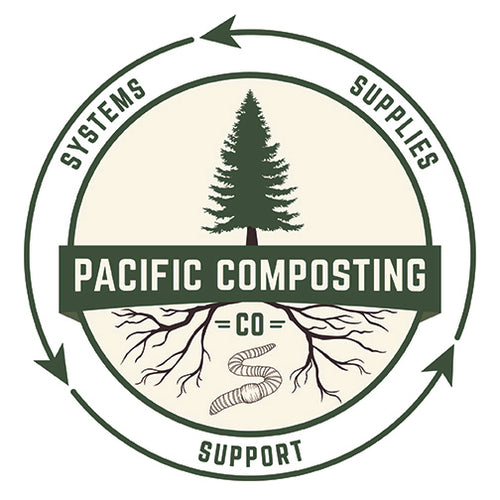This article was featured in the February issue of Cowichan Valley Voice.
Healthy, vibrant gardens begin with healthy, living soil. One of the best ways to boost soil ecology and enrich your soil naturally is with compost. While the topic of composting might not be at the front of most gardeners’ minds in February, this is actually a great time to get the ball rolling, ahead of the spring gardening season!
Our favourite composting method here at Pacific Composting, especially during the winter months, is…
Vermicomposting
This is a process that involves specialized earthworms and microorganisms teaming up to convert organic wastes into a highly-prized soil amendment called worm castings (aka vermicast or vermicompost).
One of the great things about vermicomposting is its flexibility of scale. Whether your system is small, or large, or anything in between, there’s a good chance that composting worms can help you make some beautiful black gold! Another bonus is that, unlike most other types of compost, even very small amounts of vermicast can have a major positive impact on your plants (add a small scoopful in a potted plan to see what we mean).
The Worms
To get the best results, you need the best worms for the job. Not just any ol’ “garden variety” will do - especially indoors. The #1 choice of most vermicomposters - the “Cadillac of worms” - is the Red Wiggler (Eisenia sp).
The Bin
Indoor vermicomposting involves some type of “worm bin”. Usually, it’s something fairly modest in size - that’s easy to move even when full - and is reasonably attractive. Among our favourite commercially-available bins are the Urbalive, the Hungry Bin and the Urban Worm Bag, but for those of you who are more budget-conscious, the good news is that there are a wide range of inexpensive DIY options as well.
The Set-Up
Aside from choosing the right worms, we also need to choose the right materials. Many newcomers assume all worms need soil - but composting worms are actually do much better in rich organic matter. The two main categories of material added to a worm bin are “bedding” and “food”. Bedding refers to the carbon-rich materials that should make up the bulk of your habitat (we recommend 70-80% by volume), and some great examples include shredded cardboard, coco coir, and hemp tow fibre. Foods are the rich wastes we add to feed the worms and microbes. The most common example for vermicomposters is compostable kitchen waste, like fruit and veggie scraps, coffee grounds, and tea bags.
The Rewards
With the right set-up and maintenance, you should be able to start harvesting castings within 2 to 4 months, but there’s no reason you can’t remove some smaller samples to test out, once you start seeing it accumulate in the bin. Finished castings should look like a dark, rich soil, and have a nice earthy smell. Easy ways to put castings to use include adding a small handful down in the bottom of a planting hole, using it as a top dressing around the base of plants, or using it to make a castings tea or extract.
Do Worms Give You the Willies?
We get it. Not everyone wants to keep worms in their house. Another great small-scale, indoor approach is bokashi. Although this is technically an anaerobic fermentation process (not composting), bokashi offers a very simple, odor-free way to process organic wastes indoors. It’s even easier than worm composting, and offers the added bonus of allowing you to process “no no” materials like meat and dairy as well.
Bokashi Basics
Typically, kitchen scraps and other wastes - along with a bran mix that has been colonized by a specialized group of microorganisms (known as “Effective Microorganisms” or EM) - are added to a bucket with a tight-fitting lid. For best results, you should collect your wastes for a day or two before adding them, so you aren’t constantly opening up the bucket (remember, it is an anaerobic process). Once the bucket is completely full, you should leave everything to sit undisturbed for another 2 to 3 weeks.
Using the Product
Unlike regular composting, with bokashi you aren’t left with a stablized compost that can be used right away on your plants (although a dilute extract made from bokashi leachate can be used in your garden). The finished bokashi (“pre-compost”) should be added to a larger outdoor composting system, or mixed with absorbent bedding materials and allowed to age in an aerobic environment before it gets put to use.
Pro Tip
Adding the aged/composted bokashi end product to a vermicomposting system once it becomes more worm-friendly can be an excellent way to finish it off and boost the value even more!



